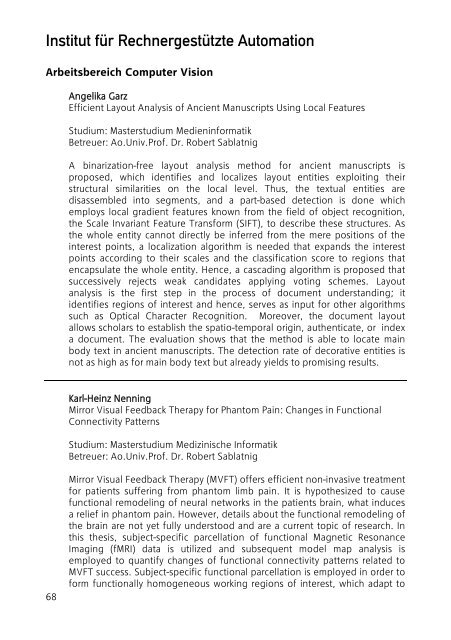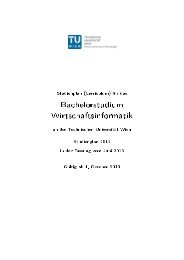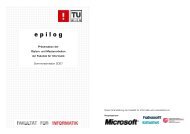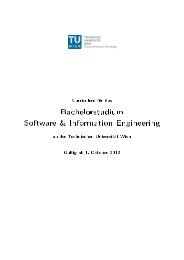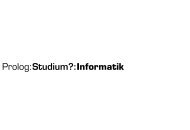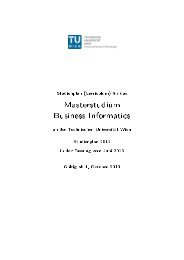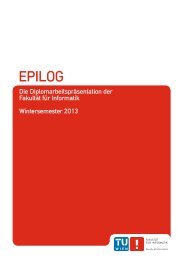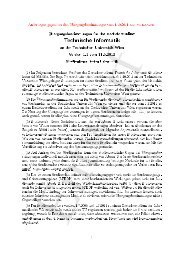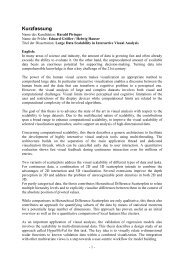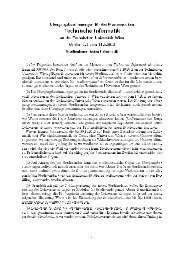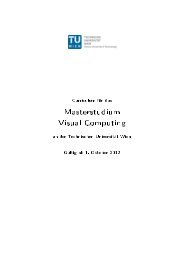Abstract-Band - Fakultät für Informatik, TU Wien - Technische ...
Abstract-Band - Fakultät für Informatik, TU Wien - Technische ...
Abstract-Band - Fakultät für Informatik, TU Wien - Technische ...
Erfolgreiche ePaper selbst erstellen
Machen Sie aus Ihren PDF Publikationen ein blätterbares Flipbook mit unserer einzigartigen Google optimierten e-Paper Software.
Institut <strong>für</strong> Rechnergestützte Automation<br />
Arbeitsbereich Computer Vision<br />
Angelika Garz<br />
Efficient Layout Analysis of Ancient Manuscripts Using Local Features<br />
Studium: Masterstudium Medieninformatik<br />
Betreuer: Ao.Univ.Prof. Dr. Robert Sablatnig<br />
A binarization-free layout analysis method for ancient manuscripts is<br />
proposed, which identifies and localizes layout entities exploiting their<br />
structural similarities on the local level. Thus, the textual entities are<br />
disassembled into segments, and a part-based detection is done which<br />
employs local gradient features known from the field of object recognition,<br />
the Scale Invariant Feature Transform (SIFT), to describe these structures. As<br />
the whole entity cannot directly be inferred from the mere positions of the<br />
interest points, a localization algorithm is needed that expands the interest<br />
points according to their scales and the classification score to regions that<br />
encapsulate the whole entity. Hence, a cascading algorithm is proposed that<br />
successively rejects weak candidates applying voting schemes. Layout<br />
analysis is the first step in the process of document understanding; it<br />
identifies regions of interest and hence, serves as input for other algorithms<br />
such as Optical Character Recognition. Moreover, the document layout<br />
allows scholars to establish the spatio-temporal origin, authenticate, or index<br />
a document. The evaluation shows that the method is able to locate main<br />
body text in ancient manuscripts. The detection rate of decorative entities is<br />
not as high as for main body text but already yields to promising results.<br />
Karl-Heinz Nenning<br />
Mirror Visual Feedback Therapy for Phantom Pain: Changes in Functional<br />
Connectivity Patterns<br />
Studium: Masterstudium Medizinische <strong>Informatik</strong><br />
Betreuer: Ao.Univ.Prof. Dr. Robert Sablatnig<br />
68<br />
Mirror Visual Feedback Therapy (MVFT) offers efficient non-invasive treatment<br />
for patients suffering from phantom limb pain. It is hypothesized to cause<br />
functional remodeling of neural networks in the patients brain, what induces<br />
a relief in phantom pain. However, details about the functional remodeling of<br />
the brain are not yet fully understood and are a current topic of research. In<br />
this thesis, subject-specific parcellation of functional Magnetic Resonance<br />
Imaging (fMRI) data is utilized and subsequent model map analysis is<br />
employed to quantify changes of functional connectivity patterns related to<br />
MVFT success. Subject-specific functional parcellation is employed in order to<br />
form functionally homogeneous working regions of interest, which adapt to


